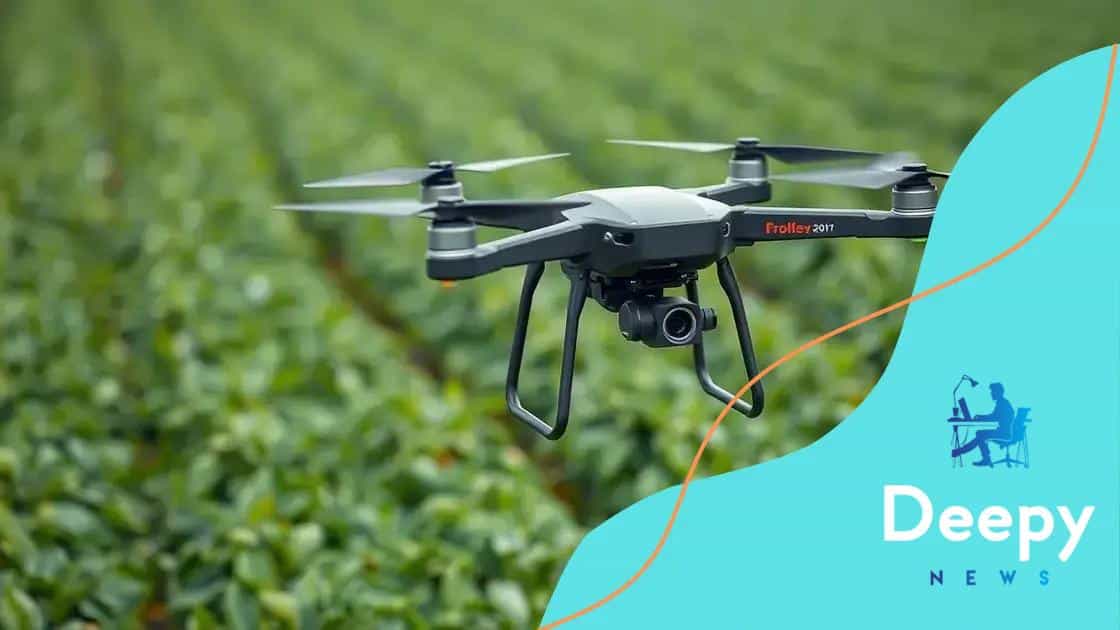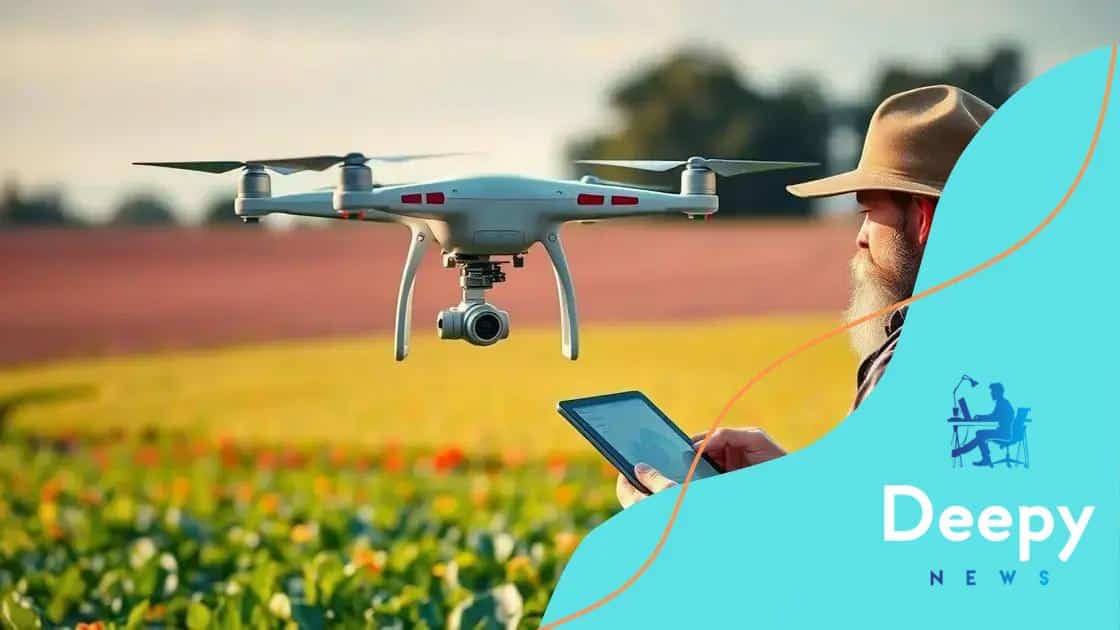The role of drones in modern agriculture

The role of drones in modern agriculture includes precision monitoring of crop health, efficient resource management, and enhanced data analytics, leading to increased productivity and sustainability in farming practices.
The role of drones in modern agriculture is becoming increasingly significant, offering farmers innovative ways to enhance productivity. Have you ever wondered how these flying devices can impact farming practices? Let’s dive into the incredible world of agricultural drones.
Understanding drone technology in agriculture
Understanding drone technology in agriculture involves recognizing how these advanced tools are changing farming techniques. Drones are not just for aerial photography; they have become vital in crop management. They allow farmers to gather detailed data efficiently, improving decision-making.
How Drones Work
Drones equipped with various sensors can collect valuable information about crops. These sensors can measure things like moisture levels, plant health, and even pest infestations. This technology enables farmers to address issues before they become serious problems.
Benefits of Using Drones
- Increased efficiency in monitoring crops.
- Reduction in costs associated with traditional farming methods.
- Ability to access hard-to-reach areas of farmland.
- Timely data collection for better decision-making.
The data from drones is processed to create detailed maps and reports. This allows farmers to make informed decisions about planting, irrigation, and fertilization. Being able to see a bird’s-eye view of their fields gives farmers a clearer understanding of crop conditions.
Moreover, drones can be used for precision agriculture, which is all about applying the right amount of inputs at the right time and place. This practice helps maximize yields while minimizing waste. When farmers apply water and fertilizers precisely where needed, they not only save money but also help protect the environment.
As drone technology continues to evolve, we can expect even more innovative applications in agriculture. With advancements in artificial intelligence and machine learning, the data gathered can lead to increasingly accurate predictions about crop performance.
This technology is a game-changer for the agricultural sector, providing people with tools that help feed our growing population. By embracing drone technology, farmers can also support sustainable practices, which are essential for future generations.
Benefits of using drones for crop monitoring
Using drones for crop monitoring offers numerous benefits that significantly enhance agricultural practices. These cutting-edge devices provide farmers with an efficient way to oversee large expanses of land, making it easier to track crop health.
Enhanced Data Collection
Drones gather essential data quickly and accurately. Equipped with high-resolution cameras and sensors, they can identify plant health, moisture levels, and pest issues. This data helps in making informed decisions.
Cost-Effectiveness
- Reduces costs related to traditional monitoring methods.
- Minimizes the need for manual labor in vast fields.
- Helps in early problem detection, preventing larger issues.
- Optimizes the use of resources, like water and fertilizers.
Additionally, the implementation of drones can lead to significant savings. By identifying areas that need attention early on, farmers can decrease resource waste. This not only saves money but also promotes sustainability.
The ability to monitor crops from above provides a unique vantage point. Farmers can quickly spot issues that might be missed from the ground, such as uneven growth patterns or irrigation problems. Furthermore, drones can access hard-to-reach areas, ensuring that every part of the field is monitored effectively.
Over time, the data collected by drones can be analyzed for trends. This analysis can inform better crop management practices. For instance, by understanding which areas of a field perform better, farmers can make smarter decisions about planting and resource allocation.
The integration of drones into routine agricultural practices is transforming how farming is done. As technology continues to evolve, the benefits of using drones for crop monitoring will only grow, leading to more sustainable and productive farming methods.
Drones and precision agriculture

Drones and precision agriculture are revolutionizing the way farmers manage their lands. Precision agriculture focuses on optimizing field-level management regarding crop farming. Using drones allows farmers to gather accurate data that helps improve yield while reducing waste.
How Drones Enhance Precision Agriculture
Drones equipped with advanced sensors can monitor various factors affecting crop growth. These factors include temperature, humidity, and soil conditions. By analyzing this data, farmers can make informed decisions about irrigation and fertilization.
Key Benefits of Drones in Precision Agriculture
- Real-time monitoring of crop health.
- Efficient use of water and fertilizers.
- Identification of pest infestations early.
- Reduction of resource waste and overall costs.
The integration of drones into everyday farming practices allows for better resource management. For instance, a farmer can use drone data to determine which areas of a field require more water or specific nutrients. This targeted approach is much more efficient than traditional methods.
In addition to monitoring, drones also aid in mapping fields. High-resolution images can create detailed maps that reveal issues like drainage problems or soil variability. With this information, farmers can adjust their practices to improve productivity.
As technology advances, the use of drones in precision agriculture is likely to become more common. Innovations could lead to even greater efficiencies, making farming more sustainable. Drones not only benefit farmers but also contribute to ensuring food security for the growing population.
Case studies: Successful drone applications
Case studies: Successful drone applications showcase how innovative technology can transform agriculture. Many farmers around the world have adopted drones, leading to improved efficiency and productivity.
Success Story 1: Crop Health Monitoring
A farmer in California used drones to monitor crop health over a large vineyard. The drone captured high-resolution images, revealing areas that were underperforming due to disease. By addressing these issues early, the farmer increased yield by 15% within just one season.
Success Story 2: Precision Irrigation
In Texas, another farmer integrated drone technology for precision irrigation. The drone mapped the field and identified dry spots that needed extra water. Implementing these findings allowed the farmer to reduce water usage by 25%, conserving resources while maintaining crop health.
Success Story 3: Pest Detection
- A farmer in Brazil utilized drones for early pest detection. The technology helped identify infestations before they spread.
- By treating affected areas quickly, the farmer saved thousands on pesticide costs.
- The drone images also provided insights into pest patterns, improving future prevention strategies.
These real-world examples demonstrate the impact of drones in agriculture. Farmers have seen tangible benefits such as enhanced monitoring, better resource management, and increased profitability. With technology continuing to evolve, the potential for drone applications in farming is vast and encourages further adoption.
Future trends in agricultural drone technology
Future trends in agricultural drone technology indicate a promising future for farming practices. As technology advances, drones are becoming more efficient and accessible to farmers worldwide. This evolution could lead to even greater changes in how crops are monitored and managed.
Increased Automation
One major trend is the move toward increased automation. Drones are likely to be integrated with autonomous systems, allowing them to operate with minimal human intervention. This advancement will enable continuous monitoring of fields, collecting data in real-time without the need for constant oversight.
Advanced Data Analytics
- Future drones will use artificial intelligence to analyze data on-the-fly.
- Farmers will receive actionable insights instantly, improving decision-making.
- This could include predictive analytics for crop yields based on historical data.
- Such capabilities will enhance precision agriculture methods further.
Additionally, with the rise of advanced sensors, drones will gather even more detailed information about soil health and crop conditions. These tools will help farmers understand their fields better, enabling more targeted approaches. For example, knowing exactly when and where to apply fertilizers will reduce waste and improve overall crop health.
Furthermore, the cost of drone technology is expected to decrease as it becomes more popular. As more companies enter the market, farmers will have access to a wider range of affordable options. This democratization of technology will empower small-scale farmers to implement sophisticated systems that were once only available to large agribusinesses.
The integration of drones with other technologies, like the Internet of Things (IoT), will create a seamless farming experience. Sensors placed in fields can communicate with drones, providing up-to-date information that helps farmers make quick decisions. Such connectivity will enhance efficiency across farming operations.
FAQ – Frequently Asked Questions about Drones in Agriculture
How do drones improve crop monitoring?
Drones provide high-resolution images and data that help farmers monitor crop health, moisture levels, and identify diseases early.
What are the benefits of using drones in precision agriculture?
Drones enhance efficiency, reduce resource waste, and allow for targeted application of water and fertilizers, ultimately improving yields.
Are drones expensive to implement for farming?
While there is an initial investment, the costs of drone technology are decreasing, making them more accessible for farmers of all sizes.
How can drones contribute to sustainability in agriculture?
Drones help optimize resource use, reduce waste, and provide valuable data for sustainable farming practices, minimizing environmental impact.






